A Practical Framework for Evaluating SEO Performance


Hand off the toughest tasks in SEO, PPC, and content without compromising quality
Explore ServicesOne thing’s for sure: SEO is the engine that drives organic growth.
But even the most well-oiled machines need a tune-up every now and then.
This is your guide to evaluating SEO performance, designed to help you pinpoint what’s killing it, what’s not, and what needs to be torched… literally, to the ground.
There’s a lot here, so feel free to use the jump links listed above to skip ahead.
Lessgo! 👇
Complete Guide to Evaluating SEO Performance in 2025
I’ve broken this framework into five areas:
- Technical assessment
- Content evaluation
- On-page analysis
- Off-page metrics
- Performance tracking
Starting with the first one, technical assessment:
1. Technical Assessment
Let’s be sure the technical foundations of the site in question are up to scratch.
Site Audit Results

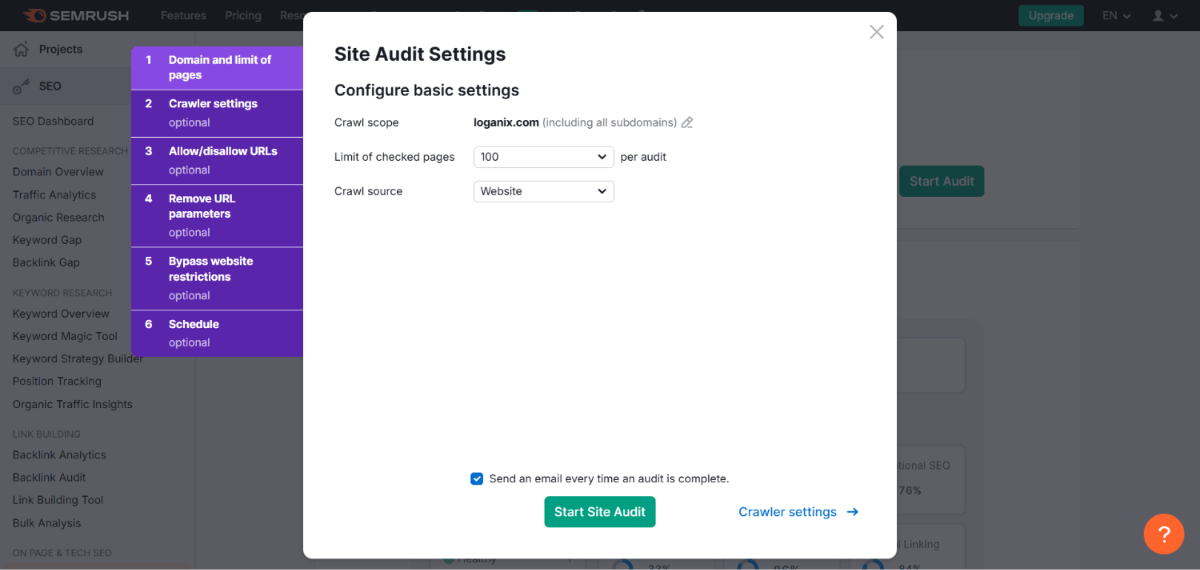
For those readers who are new to this, think of a site audit as a health check for a website, putting the technical aspects of a website under a microscope.
Key metrics:
- Internal linking problems
- International SEO issues
- AMP issues
- Crawl errors
- Performance issues like page load speed and file minification
- Security warnings
- XML sitemap errors
Tools:
- Semrush Site Audit
- Screaming Frog SEO Spider
- Ahrefs
- Google PageSpeed Insights
Improvement strategies:
- Fix crawl errors
- Optimize site structure
- Tweak for page speed
- Ensure mobile optimization
- Implement security measures
Success benchmarks:
- No site is perfect, but aim for zero broken links.
- Strive for minimal to no crawl errors reported in tools like Google Search Console.
- Target load times under 2.5 seconds to enhance user experience.
- Achieve a mobile-friendly status with no usability errors.
- Ensure the site is fully HTTPS with no security warnings.
Server Performance

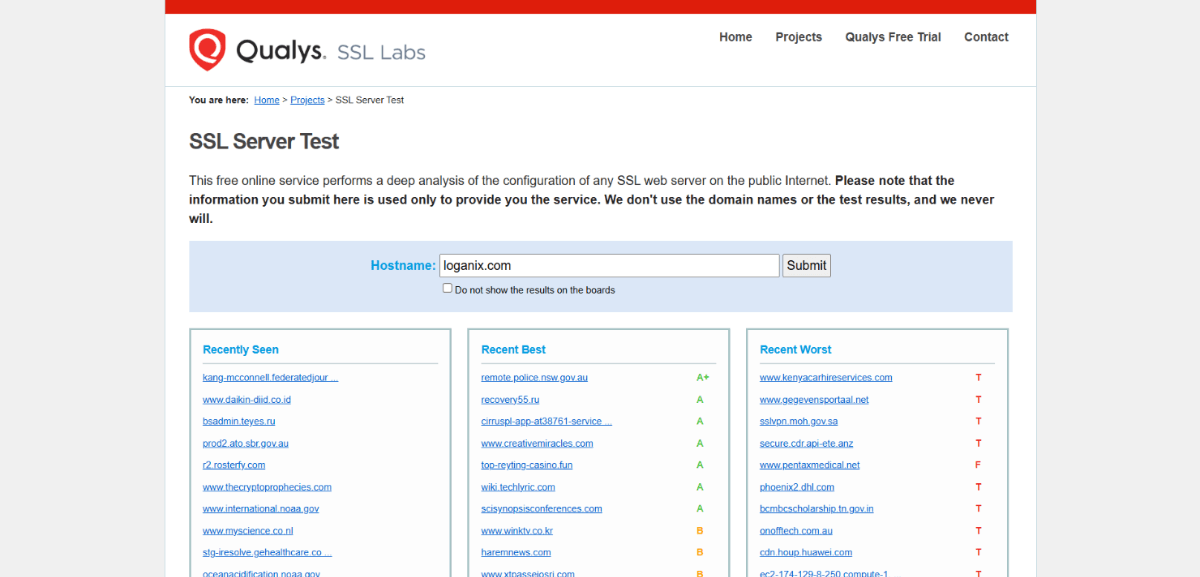
Next, we’re looking for any server-side issues that could be slowing down your website or making it unreliable.
Key metrics:
- Server response time
- Uptime
- Error rate
- Time to First Byte (TTFB)
- CPU usage
- Memory usage
Tools:
- SSL Labs
- SEO Site Checkup
- Screaming Frog
Improvement strategies:
- Choose a reliable hosting provider
- Optimize server configuration
- Use a content delivery network (CDN)
Success benchmarks:
- Aim for a server response time of under 200 milliseconds.
- 99.9% uptime or higher is the gold standard.
- Server errors should be rare occurrences.
- THe server should have enough resources to handle traffic without becoming overloaded.
Mobile Optimization
This time, we’re looking at how well your website is optimized for mobile devices, including factors like responsiveness, page speed, and usability.
Key metrics:
- Mobile page speed
- Mobile usability
- Responsive design
- Core Web Vitals (Mobile)
Tools:
- Google PageSpeed Insights
- Pingdom
- GTmetrix
Improvement strategies:
- Use responsive design
- Optimize images for mobile
- Prioritize mobile-first indexing
- Minimize pop-ups
- Improve touch elements
Success benchmarks:
- The site should get a green light from Google’s PageSpeed Insights.
- Aim for a page load time of under 3 seconds on mobile devices.
- Users can easily navigate the website and find what they’re looking for on their smartphones and tablets.
- The website provides a positive user experience on mobile devices, as measured by Core Web Vitals.
Security Measures
Now, we’re looking at how well a website is protected from online threats, including malware, hacking attempts, and data breaches.
Key metrics:
- HTTPS status
- SSL certificate validity
- Security software
- Vulnerability scanning
- Password security
- Software updates
Tools:
- SSL Labs
- Sucuri SiteCheck
- Observatory by Mozilla
- Qualys SSL Labs
Improvement strategies:
- Implement HTTPS
- Keep software updated
- Use strong passwords
- Implement two-factor authentication
- Use a web application firewall (WAF)
- Regularly monitor logs and conduct security audits
Success benchmarks:
- All pages are secured with HTTPS.
- SSL certificates are up-to-date and properly configured.
- The security software is regularly updated to protect against the latest threats.
- Regular vulnerability scans show no critical security weaknesses.
- All website accounts are protected with strong passwords and two-factor authentication.
Site Structure

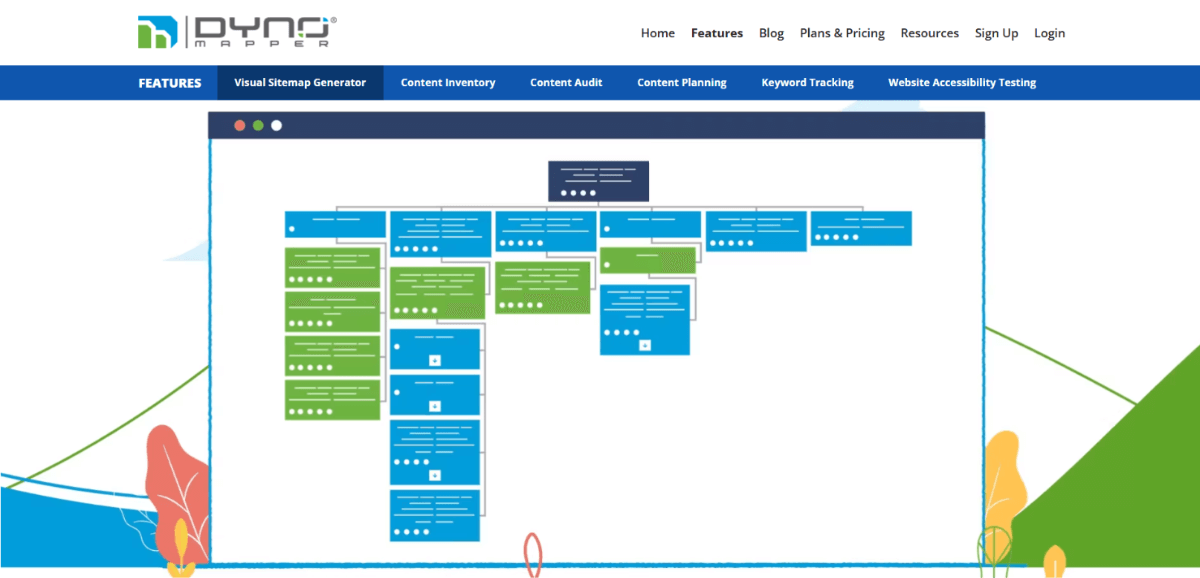
Up next? We’re looking at how a website is organized, how easy it is to navigate, and how effectively you’re using internal linking to guide users and search engines.
Key metrics:
- Logical hierarchy
- Clear navigation
- Internal linking
- Click depth
- Orphan pages
- XML sitemap
- HTML sitemap
Tools:
- Screaming Frog SEO Spider
- Dynomapper
- Google Search Console
Improvement strategies:
- Use a clear and logical hierarchy
- Implement clear navigation
- Use internal links strategically
- Create an XML sitemap
- Consider an HTML sitemap
Success benchmarks:
- The website’s structure is easy to understand and navigate.
- Users can easily find what they’re looking for.
- Internal links guide users and search engines to relevant content.
- Important pages are easily accessible from the homepage.
- All pages are linked to from at least one other page on the site.
- The sitemaps accurately reflect the website’s structure and content.
2. Content Evaluation
What good is a technically sound website if the content is bland, outdated, or irrelevant? Let’s look at how you can measure a site’s content quality.
Quality Metrics


We’re looking at the characteristics that make content truly stand out, from accuracy and clarity to comprehensiveness and engagement.
Key metrics:
- Accuracy
- Clarity
- Comprehensiveness
- Engagement
- Readability
- Originality
- Credibility
Tools:
- Grammarly
- Hemingway editor
- Google Analytics
- Clearscope
- Surfer SEO
- MarketMuse
Improvements strategies:
- Fact-check content
- Use clear and concise language
- Provide in-depth information
- Use visuals to enhance engagement
- Focus on readability
- Write with your audience in mind
Success benchmarks:
- Content is accurate, clear, comprehensive, and engaging.
- Users spend significant time on the page.
- Low bounce rate.
- Content is shared on social media and earns backlinks.
- Content ranks well for relevant keywords.
Topic Coverage

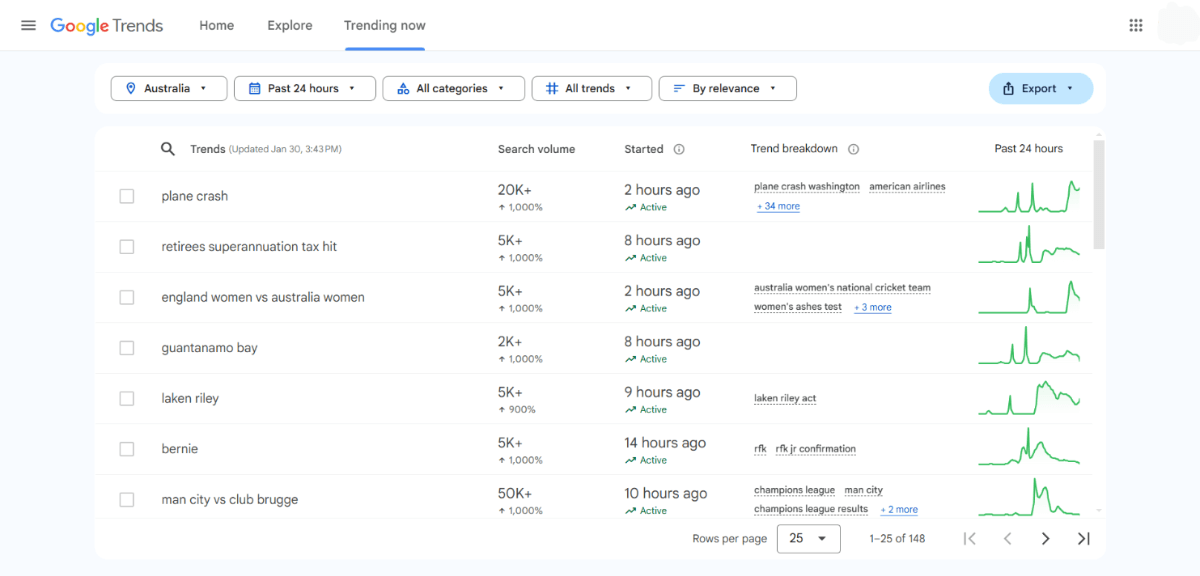
Okay, now, let’s take a look at how well the website in question covers relevant topics, identifies potential content gaps, and creates a content strategy that aligns with user search intent.
Key metrics:
- Keyword research
- Content mapping
- Competitor analysis
- Search intent
- Content depth
- Content freshness
Tools:
- SEMrush
- Ahrefs
- BuzzSumo
- Google Trends
Improvement strategies:
- Conduct thorough keyword research
- Create a content map
- Analyze competitor websites
- Align content with search intent
- Keep content fresh
Success benchmarks:
- Website covers relevant topics comprehensively.
- Content is well-structured and easy to navigate.
- Website ranks for relevant keywords.
- Content earns backlinks and social shares.
Content Freshness
How fresh is the content? Like, fresh, fresh, or so-so fresh? Let’s look at how often you should update a site’s content, how relevant it is to current trends and events, and how well you’re incorporating new information and perspectives.
Key metrics:
- Content update frequency
- Content publication frequency
- Content relevance
- Content decay
Tools:
- Content Management System (CMS)
- Google Analytics
- Google Search Console
Improvement strategies:
- Update content regularly
- Create new content
- Repurpose old content
- Create evergreen content
Success Benchmarks:
- Content is updated regularly.
- Content is relevant to current trends and events.
- Website attracts consistent organic traffic.
- Content earns backlinks and social shares.
- Content ranks well for relevant keywords.
E-E-A-T Signals
Up next, we’re looking at Experience, Expertise, Authoritativeness, and Trustworthiness, a.k.a E-E-A-T, Google’s way of sizing up your content’s credibility and authority.
Key metrics:
- Author credentials
- Website reputation
- Content accuracy
- Transparency
- Security
Tools:
- Moz
- SEMrush
- Google Search Console
Improvement strategies:
- Showcase author credentials
- Build a strong website reputation
- Ensure content accuracy
- Be transparent
- Prioritize security
Success benchmarks:
- Content is written by credible authors.
- Website has a good reputation.
- Content is accurate and supported by evidence.
- Website is transparent about its purpose and ownership.
- Website is secure and protects user data.
Content Gaps

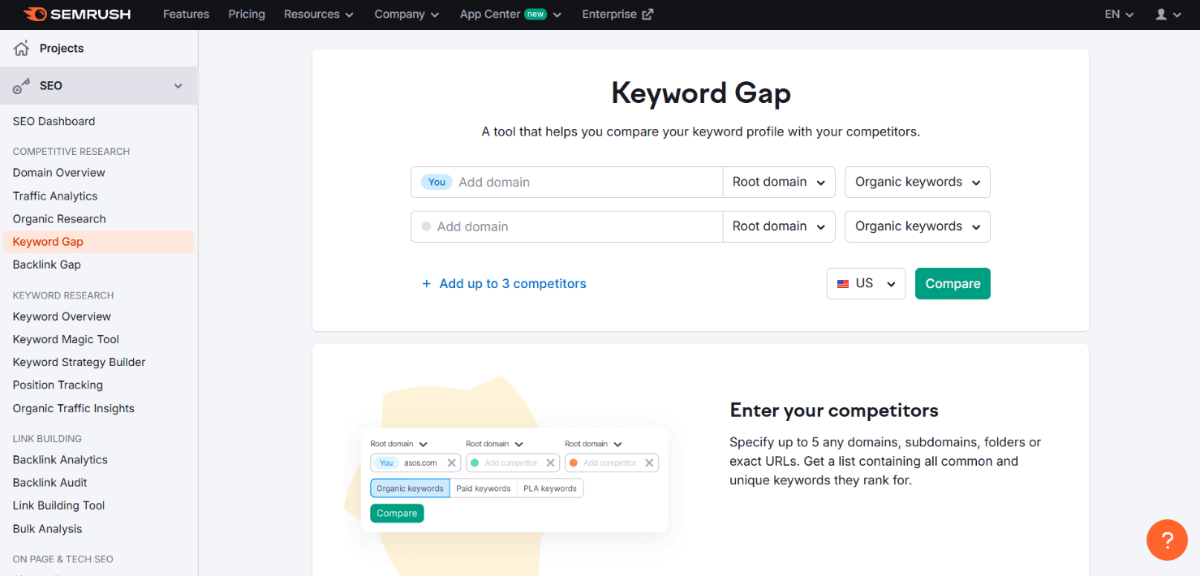
Content gaps: ways a site could be providing more valuable content to its target audience.
Key metrics:
- Keyword Gap analysis
- Content Gap analysis
- Search intent
- Content depth
- Content format
Tools:
- Semrush
- Ahrefs
- BuzzSumo
Improvement strategies:
- Conduct keyword gap analysis
- Analyze competitor content
- Use content briefs
- Diversify content formats
- Prioritize high-value keywords
Success benchmarks:
- No significant content gaps.
- Website ranks for relevant keywords.
- Website attracts a wider audience.
- Content earns backlinks and social shares.
- Content drives conversions.
3. On-Page Analysis
On-page analysis is all about fine-tuning each page on a website to make it as search-engine-friendly as possible. Let’s find out how you can measure that.
Meta Optimization
Next, we’re looking at how well a site’s meta tags are optimized to attract clicks and improve its visibility in search results.
Key metrics:
- Title tag length
- Meta description length
- Keyword usage
- Click-through rate (CTR)
- Uniqueness
- Compelling language
Tools:
- Semrush On-Page SEO Checker
- MozBar
- Google Search Console
Improvement strategies:
- Write compelling title tags
- Craft informative meta descriptions
- Monitor CTR
- A/B test different versions
Success benchmarks:
- Title tags and meta descriptions are optimized for length and keyword usage.
- High CTR for relevant keywords.
- Unique meta tags for each page.
- Engaging and compelling language.
Internal Linking

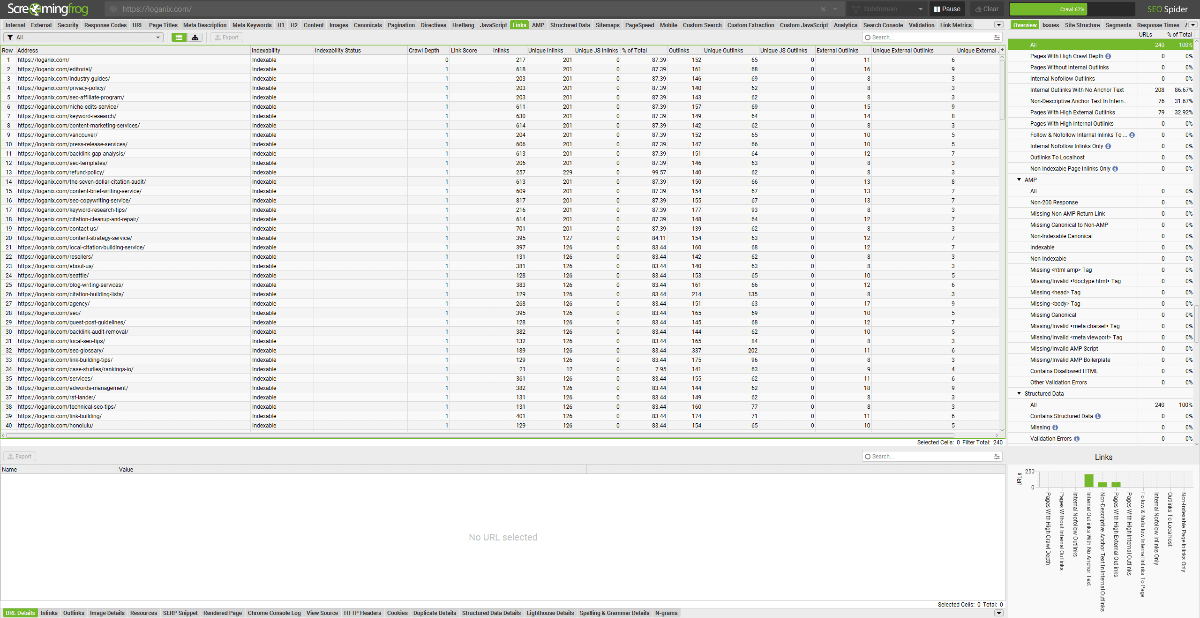
Internal linking is up next. We’re looking at how to effectively use internal links to streamline user navigation, distribute link equity, and provide context to search engines.
Key metrics:
- Number of internal links
- Anchor text
- Link relevance
- Link position
- Click depth
- Orphan pages
Tools:
- Screaming Frog SEO Spider
- Semrush Site Audit
Improvement strategies:
- Use descriptive anchor text
- Link to relevant pages
- Use a variety of anchor text
- Link to important pages
- Use internal links to improve navigation
Success benchmarks:
- Sufficient number of internal links.
- Descriptive and relevant anchor text.
- Internal links point to relevant pages.
- Internal links are placed naturally within the content.
- No orphan pages.
URL Structure
Let’s now look at how a site’s URLs are structured, how readable they are, and how well they incorporate relevant keywords.
Key metrics:
- URL length
- Keyword usage
- Readability
- Consistency
- Relevance
- Case sensitivity
Tools:
- Screaming Frog SEO Spider
- Semrush Site Audit
Improvement strategies:
- Use short and descriptive URLs
- Include keywords in URLs
- Use hyphens to separate words
- Avoid using underscores
- Use lowercase letters
- Create a consistent structure
Success benchmarks:
- Short and descriptive URLs.
- Relevant keywords are used in URLs.
- URLs are easy to read and understand.
- URLs are consistent across the website.
- URLs accurately reflect the content of the page.
- URLs are consistently lowercase.
Schema Markup
Now, let’s dig into how effectively you’re using schema markup to enhance a website’s visibility in search results and provide more informative and engaging search listings.
Key metrics:
- Schema markup implementation
- Schema markup type
- Schema markup validity
- Rich snippet appearance
- Schema markup coverage
Tools:
- Google’s Rich Results Test
- Semrush Site Audit
- Schema Markup Generator
Improvement strategies:
- Implement relevant schema markup
- Monitor rich results
- Keep schema markup up-to-date
Success benchmarks:
- Relevant schema markup is implemented correctly.
- Website appears in rich results.
- Rich snippets improve click-through rate.
- Schema markup is kept up-to-date.
Page Speed


We’re looking at how quickly your pages load, what factors might be slowing them down, and how you can optimize them for a lightning-fast experience.
Key metrics:
- Page load time
- Time to First Byte (TTFB)
- Largest Contentful Paint (LCP)
- Interaction to Next Paint (INP)
- Cumulative Layout Shift (CLS)
- Page size
- Number of requests
Tools:
- Google PageSpeed Insights
- GTmetrix
- WebPageTest
Improvement strategies:
- Optimize images
- Leverage browser caching
- Minify code
- Use a content delivery network (CDN)
- Improve server response time
- Defer loading of non-critical resources
Success benchmarks:
- Aim for a page load time of under 2 seconds.
- A TTFB of under 500 milliseconds is ideal.
- Aim for an LCP of under 2.5 seconds.
- An INP of under 100 milliseconds is considered good.
- A CLS of under 0.1 is ideal.
- Keep page size and number of requests as low as possible without sacrificing functionality or user experience.
4. Off-Page Metrics
Off-page optimization is the things you do outside of a website to boost its authority, trustworthiness, and visibility in search results. Let’s find out how you can measure that.
Backlink Profile
The overall strength and health of a backlink profile is definitely worth looking into, including the number of backlinks, the quality of the linking websites, and the diversity of your link sources.
Key metrics:
- Number of backlinks
- Referring domains
- Domain authority
- Backlink quality
- Anchor text diversity
- Backlink velocity
- Link relevance
- Link location
- Link type
Tools:
- Ahrefs
- Semrush
- Moz Link Explorer
Improvement strategies:
- Create high-quality content
- Promote content
- Guest blogging
- Broken link building
- Build relationships with other website owners
- Participate in online communities
Success benchmarks:
- High-quality backlinks from authoritative websites.
- Diverse anchor text profile.
- Steady backlink velocity.
- Links from relevant websites.
- Links placed within the main content of the page.
- A variety of link types.
Brand Mentions


Next, let’s look at how often a brand is being mentioned online, the sentiment of those mentions (positive, negative, or neutral), and the authority and relevance of the sources putting the word out.
Key metrics:
- Mention volume
- Mention sentiment
- Mention source
- Mention context
- Mention reach
- Mention engagement
Tools:
- Brand24
- Google Alerts
- BuzzSumo
- Semrush
Improvement strategies:
- Engage in public relations
- Participate in industry events
- Monitor social media
- Create shareable content
- Run contests and giveaways
- Collaborate with influencers
Success benchmarks:
- High volume of positive brand mentions.
- Mentions from authoritative and relevant sources.
- Mentions that are relevant to your products or services.
- Engaging mentions that generate social shares and interactions.
Social Signals
Now, let’s take a peek at how a site’s content is performing on social media, how engaged its audience is, and how effectively you’re using social media to amplify a brand’s reach.
Key metrics:
- Social shares
- Social engagement
- Social reach
- Social traffic
- Social sentiment
- Social mentions
- Follower growth
Tools:
- BuzzSumo
- Sprout Social
- Google Analytics
Improvement strategies:
- Share high-quality content
- Use social media advertising
- Engage with followers
- Collaborate with influencers
- Optimize social media profiles
Success benchmarks:
- High social shares and engagement.
- Growing social media following.
- Significant social media traffic.
- Positive social sentiment.
- Active engagement with an audience.
Local Citations
Okay, next, let’s look at the quantity, quality, and consistency of your local citations across the web.
Key metrics:
- Citation consistency
- Citation accuracy
- Citation authority
- Citation completeness
- Citation distribution
- Citation visibility
Analysis tools:
- Moz Local
- Whitespark
- BrightLocal
Improvement strategies:
- Claim a business’s listings
- Ensure NAP consistency
- Build citations on authoritative websites
- Use a citation management tool
- Monitor citations regularly
Success benchmarks:
- Consistent and accurate NAP information across all citations.
- Citations on authoritative and relevant websites.
- Complete and comprehensive citations.
- Citations distributed across a variety of platforms.
- Citations appearing prominently in search results.
Competitor Comparison

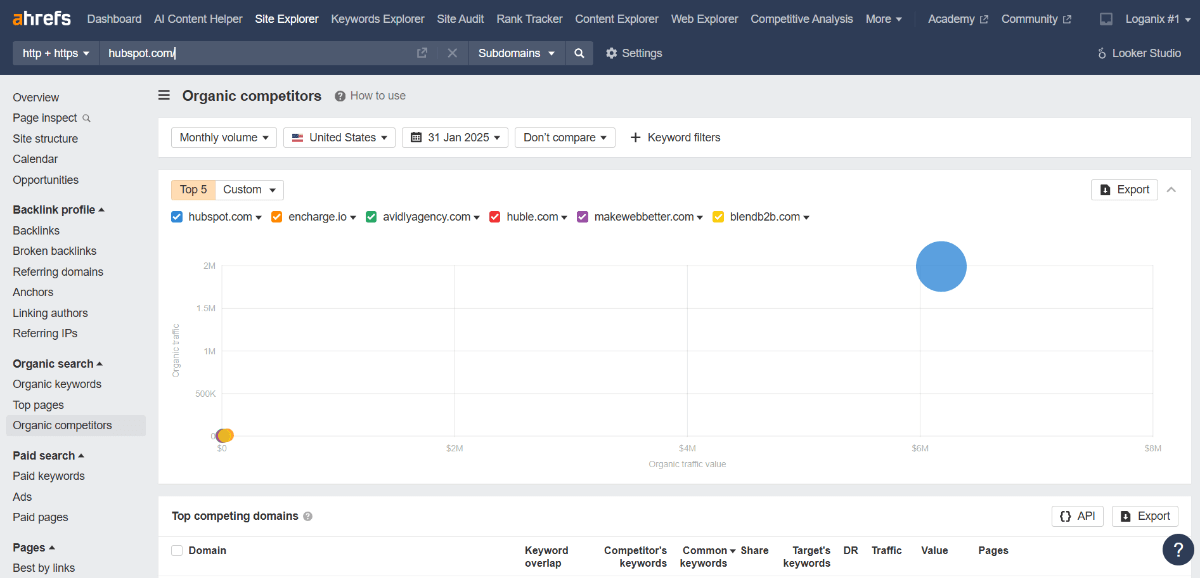
Next, let’s take a little look at how a site you’re working with stacks up against its competitors in terms of key off-page metrics, including backlinks, brand mentions, social media presence, and local citations.
Key metrics:
- Backlink profile
- Brand mentions
- Social media performance
- Local citations
- Content strategy
- Website traffic
Tools:
- Ahrefs
- Semrush
- Moz Link Explorer
- SimilarWeb
Improvement strategies:
- Identify competitor strengths and weaknesses
- Replicate successful strategies
- Find new link-building opportunities
- Improve the content strategy
- Boost social media presence
Success benchmarks:
- Comparable or better off-page metrics than competitors.
- A clear understanding of competitors’ strengths and weaknesses.
- A strategy for replicating successful competitor strategies and capitalizing on their weaknesses.
5. Performance Tracking
Last but not least, it’s time to talk about tracking your progress.
Organic Traffic
How much organic traffic a website is receiving, where that traffic is coming from, and how it’s changing over time? Let’s see how you can measure this.
Key metrics:
- Organic traffic volume
- Organic traffic sources
- Organic landing pages
- Organic keywords
- Organic traffic trends
- Organic conversion rate
- Organic traffic value
Tools:
- Google Analytics
- Google Search Console
- Semrush
- Ahrefs
Improvement strategies:
- Optimize for target keywords
- Create high-quality content
- Build backlinks
- Improve user experience
- Promote content
Success benchmarks:
- Steady increase in organic traffic volume.
- Organic traffic from relevant keywords and search engines.
- High-performing organic landing pages.
- Positive organic traffic trends.
- High organic conversion rate.
- Significant organic traffic value.
Conversions

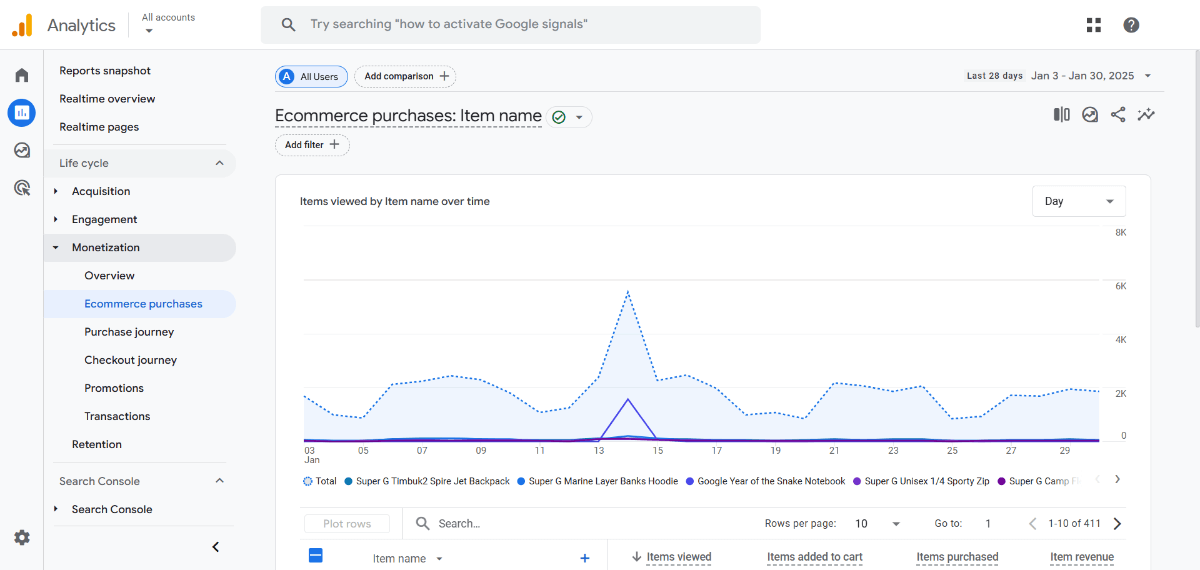
Right, conversions—this time, we’re looking at how many conversions a website is generating, where those conversions are coming from, and how conversion rates are changing over time.
Key metrics:
- Conversion rate
- Conversion sources
- Conversion pages
- Conversion keywords
- Conversion value
- Conversion trends
- Conversion attribution
Tools:
- Google Analytics
Improvement strategies:
- Optimize landing pages
- Improve user experience
- A/B test different elements
- Use persuasive copywriting
- Track and analyze data
Success benchmarks:
- High conversion rate.
- Conversions from relevant keywords and landing pages.
- Significant conversion value.
- Positive conversion trends.
- Clear conversion attribution.
Rankings
Next, we’re looking at where a website ranks for the target keywords, how those rankings are changing over time, and how rankings compare to competitors.
Key metrics:
- Keyword ranking position
- Keyword ranking trends
- Keyword ranking distribution
- Competitor rankings
- Ranking volatility
- Branded vs. Non-branded rankings
- Local rankings
Tools:
- Google Search Console
- Semrush
- Ahrefs
- Moz Rank Tracker
Improvement strategies:
- Optimize for target keywords
- Build backlinks
- Improve user experience
- Create high-quality content
- Monitor your rankings regularly
Success benchmarks:
- High keyword ranking positions for relevant keywords.
- Positive keyword ranking trends.
- Good keyword ranking distribution across different positions.
- Higher rankings than competitors.
- Stable rankings with minimal volatility.
Visibility
Okay, now, we’re looking at how visible a website is in search results, both overall and for specific keywords, and how that visibility is changing over time.
Key metrics:
- Search visibility score
- Keyword visibility
- Brand visibility
- Competitor visibility
- Visibility trends
- Visibility by device
- Visibility by location
Tools:
- Semrush
- Sistrix
- Ahrefs
Improvement strategies:
- Improve rankings
- Optimize for more keywords
- Improve click-through rate
- Earn more backlinks
- Improve content
Success benchmarks:
- High search visibility score.
- Strong visibility for target keywords.
- Higher visibility than your competitors.
- Positive visibility trends.
- Consistent visibility across all devices and locations.
ROI Metrics
And last, we’re looking at how your SEO efforts are impacting your business goals, whether it’s increased leads, sales, brand awareness, or customer lifetime value.
Key metrics:
- Conversion value
- Lead generation
- Customer Acquisition Cost (CAC)
- Customer Lifetime Value (CLTV)
- Brand awareness
- Website traffic value
Tools:
- Google Analytics
- Google Search Console
- Semrush
- Ahrefs
- CRM (Customer Relationship Management) software
Improvement strategies:
- Focus on high-value keywords
- Optimize for conversions
- Track and analyze data
- Invest in SEO tools and resources
- Consider the long-term value of SEO
Success benchmarks:
- Positive ROI.
- High conversion value.
- Low customer acquisition cost.
- High customer lifetime value.
- Increased brand awareness.
- Significant website traffic value.
Conclusion and Next Steps
Yo, you made it! What freakin’ journey that was, aye?
If, at this point, you’re staring at your screen thinking, “How in the world am I going to keep tabs on all that?” Not too worry, we’re just a few clicks away.
🚀 Simply jump over to our SEO services page and allow us to give you a helping hand. 🚀
Hand off the toughest tasks in SEO, PPC, and content without compromising quality
Explore ServicesWritten by Aaron Haynes on April 4, 2025
CEO and partner at Loganix, I believe in taking what you do best and sharing it with the world in the most transparent and powerful way possible. If I am not running the business, I am neck deep in client SEO.











